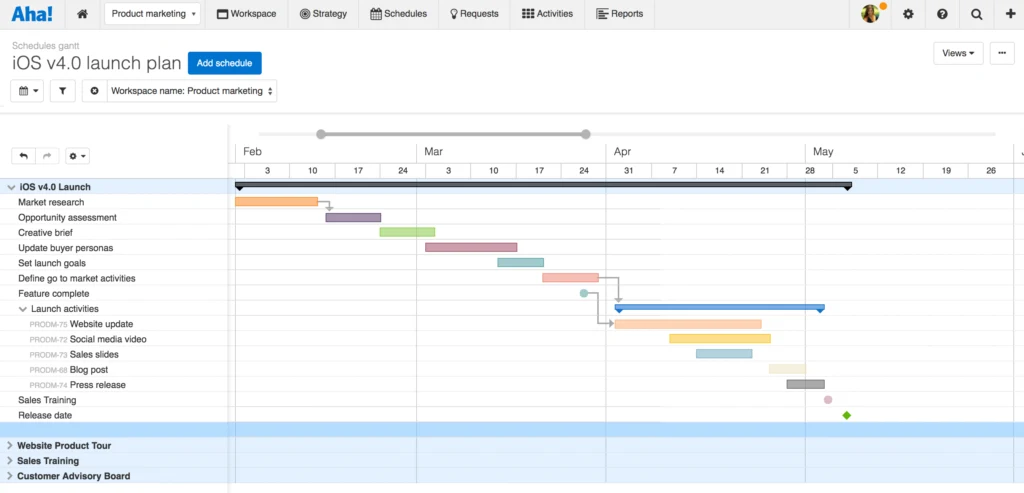
The Marketing Plan vs. The Launch Plan
“We use the word ‘strategy’ very loosely in marketing.” I read this comment on LinkedIn recently and it got me thinking. The s-word is not the only squishy one for marketing teams. There are plenty of other terms that get bandied about without a lot of clarity, like “marketing funnel” and “conversion rates.” But there are others that cause confusion, like “marketing plan” and “launch plan.”
So, what is the difference between a marketing plan and launch plan?
You can think of the marketing plan as your steady focus. This is the plan for the programs and activities you use to communicate your existing product or service to customers. The launch plan tackles something novel — something fresh. This is the plan for how you will introduce a new product or service to customers.
This is a Gantt chart, which helps you manage and visualize marketing activities and key dates.
For many teams, the launch plan is a subset of the marketing plan. This is because a comprehensive marketing plan usually contains all of the campaigns and activities that will happen over a specific course of time. But since the two plans are so closely connected, there can often be confusion around what makes them different.
In order to create effective marketing and launch plans, you need to understand what goes into each, how they relate, and where they differ. Here are the key differences:
Purpose
The purpose of a marketing plan is to define how you will achieve your marketing strategy over time. The plan serves as a tool to communicate and visualize the direction of the marketing work. It shows the team how your overall marketing activities will help you achieve your goals and deliver value to the business.
The purpose of a launch plan is to define how you will achieve your go-to-market strategy in the near future. It details the activities that need to happen to achieve this, ensuring that your launch reaches the right audience. A launch plan also ensures that no activities are overlooked by keeping the team aware and focused on the work that needs to get done before the big day.
Initiatives
The marketing plan lays out the major initiatives (or themes of work) that you will tackle over the next six months to a year. These are likely your programs and campaigns, which serve as the “containers” for your activities. Each activity should tie back to the strategy so you can make sure your day-to-day work is backed by a purpose.
The launch plan lays out one major initiative — the delivery of a new offering, feature, or program. Within this initiative, you should detail the activities leading up to launch day, including who is working on what and any major milestones with specific due dates. You should also track cross-functional efforts, noting any dependencies so that everyone is aligned on timing and impact.
Audience
The marketing plan is created for the broader internal marketing team (product, digital, content) as well as other cross-functional contributors. Depending on the scope of programs, there are likely two audiences. For a detailed view, the framework may be created by marketing leaders with the drill-down into activities for the broader team to track and complete. A streamlined view of this plan is usually helpful for the leadership team, focusing on major initiatives and how each marketing effort will bring value to the business.
The product marketing team will likely “own” the launch plan if what is being launched is offering-related, but they should share it internally with marketing and other cross-functional teammates. This keeps everyone on track and accountable for the activities that need to get done for launch day. You will want members of marketing as well as product, sales, support, engineering, and even legal to be brought into and aware of the plan.
Timeline
The marketing plan lays out the campaigns and programs that you will focus on over time. For many marketing teams this planning is done quarterly or even annually. Some may create a new plan for each half of the year or at the beginning of each fiscal year, while others may create more incremental plans based on the company’s business cycle.
The timeline of your launch plan is tied obviously to the launch date. Depending on the complexity of your launch, you will need to create the plan anywhere from three months to one year in advance. The plan should also include your post-launch efforts — what needs to happen after launch day — such as getting customer feedback or optimizing your website.
The marketing plan takes the long view while the launch plan is more focused on what is new and next.
So yes, the two plans have separate and distinct purposes. But they also have something that binds them together — the strategy. Each should tie back to your overall marketing strategy, helping you and your team drive the growth of the business.
Build product and marketing plans like you always wanted. Sign up for a free 30-day trial of Aha! Roadmaps.
Related:





